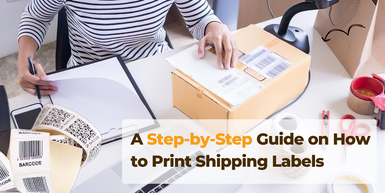Posted by Label Warehouse on 5th Feb 2024
A Step-by-Step Guide on How to Print Shipping Labels
In the realm of logistics and eCommerce, the significance of shipping labels and freight labels cannot be overstated. These labels play a pivotal role in facilitating the seamless movement of packages from sender to recipient. Print shipping labels typically contain crucial information such as the sender's and recipient's addresses, package weight, and dimensions. They serve as a vital link between the sender and the shipping carrier, ensuring that packages reach their intended destinations efficiently. Shipping labels, encompassing both standard and freight labels, contribute to the overall efficiency and accuracy of the shipping process. Freight labels, specifically designed for larger shipments, include additional details such as freight class and special handling instructions. The accuracy of these labels is paramount for smooth operations, minimising the risk of errors and delays. In essence, print shipping labels and freight labels collectively form an integral part of the logistics puzzle, facilitating the movement of goods and products in the global marketplace.
This step-by-step guide will walk you through the process of creating and printing shipping labels, ensuring a smooth and hassle-free shipping experience. So, let's dive into the world of print shipping labels and freight labels.
Let’s start by discussing-
What are Shipping Labels?
Shipping labels are essential components in the logistics and shipping industry, serving as a key identifier and communicator for packages in transit. These labels typically contain crucial information such as the sender's and recipient's addresses, package dimensions, weight, and tracking details. The primary purpose of shipping labels is to provide clear and accurate instructions to shipping carriers, ensuring that packages are directed to their intended destinations. Often generated through online platforms provided by shipping carriers like USPS, UPS, or FedEx, these labels streamline the shipping process, enabling efficient tracking and timely deliveries. In essence, shipping labels are the informational backbone of the shipping journey, facilitating a smooth and organised flow of packages from point A to point B in the complex web of global logistics. Their accuracy and clarity play a pivotal role in minimising errors and delays, making them a fundamental aspect of modern supply chain management.
Shipping Label Types
Standard Shipping Labels
- These are the most common shipping labels used for regular-sized packages and parcels.
- Include essential details like the sender's address, recipient's address, package weight, and tracking information.
Express Shipping Labels
- Designed for expedited shipping services, these labels indicate a faster delivery option.
- Often associated with premium shipping services, such as next-day or 2-day delivery.
International Shipping Labels
- Specifically tailored for packages destined for international destinations.
- Include additional information required for customs clearance, such as content details and declaration of value.
Fragile or Handle with Care Labels
- Alert carriers and handlers to exercise caution due to the fragile nature of the contents.
- Often accompanied by symbols or text indicating delicate items.
Hazardous Materials Labels
- Required for packages containing substances deemed hazardous or dangerous during transport.
- Comply with international regulations for the safe handling and transportation of such materials.
Return Shipping Labels
- Generated by the sender to facilitate the return of items by the recipient.
- Include information for the reverse journey, making the return process more straightforward.
Bulk Shipping Labels
- Used for larger shipments or palletised goods.
- May include additional information such as freight class, pallet weight, and handling instructions.
Integrated Shipping Labels
- Combine both shipping label and packing slip on a single document for more streamlined order fulfilment.
- Enhance efficiency by reducing the need for separate paperwork.
Thermal Shipping Labels
- Printed using thermal printers without the need for ink or toner.
- Ideal for high-volume shipping operations due to their quick printing capabilities.
Custom Branded Shipping Labels
- Personalised labels with a company's logo, colours, or other branding elements.
- Enhance brand visibility and recognition during the shipping process.
Smart Shipping Labels
- Utilise technology like RFID or QR codes for enhanced tracking and visibility.
- Enable real-time monitoring of the package's location and status.
Difference between Shipping Labels & Freight Labels
Shipping labels and freight labels are both crucial components of the logistics and transportation industry, but they serve different purposes and are associated with distinct types of shipments. Here's a breakdown of the key differences between shipping labels and freight labels:
Shipping Labels
Type of Shipments
- Shipping labels are primarily used for standard-sized packages and parcels that are typically handled by regular parcel carriers like USPS, UPS, or FedEx.
- Suitable for individual consumer shipments, eCommerce orders, and smaller business-to-business transactions.
Information Included
- Shipping labels contain essential information such as the sender's and recipient's addresses, package weight, dimensions, and tracking information.
- Often include a barcode or QR code for efficient tracking throughout the shipping process.
Printing Format
- Shipping labels can be printed on standard paper or adhesive labels and are typically generated through online platforms provided by shipping carriers.
- Available in various formats, including PDFs, which can be printed and attached to the package.
Visibility and Convenience
- Designed for ease of use, shipping labels are easily readable and can be affixed to packages of various sizes.
- Commonly used in eCommerce and retail settings where individual shipments are frequent.
Freight Labels
Type of Shipments
- Freight labels are specifically designed for larger shipments that are transported using freight or cargo carriers, often involving palletised goods.
- Suitable for business-to-business shipments, industrial equipment, or bulk goods.
Information Included
- In addition to standard shipping label information, freight labels include details specific to larger shipments, such as freight class, handling instructions, and pallet information.
- May also include special labels indicating hazardous materials or fragile contents.
Printing Format
- Freight labels are often printed on larger, more durable materials suitable for industrial environments.
- Customised to accommodate the specific requirements of freight carriers and the handling of large quantities of goods.
Application and Handling
- Freight labels are typically applied to pallets or larger shipping containers, and they may need to meet industry-specific regulations and standards.
- Handling considerations, such as proper placement on a pallet, are crucial for efficient transportation within the freight network.
Choosing the Right Shipping Labels
Choosing the right shipping label are crucial for ensuring a smooth and efficient shipping process. Here are some key factors to consider when making your selection:
Package Size and Weight
Different shipping labels are designed for various package sizes and weights. Ensure that the label you choose accommodates the dimensions and weight of your package.
Shipping Destination
If you're shipping internationally, make sure to use labels specifically designed for international shipments. These labels typically include additional information required for customs clearance.
Shipping Speed
Consider the urgency of the delivery. If you need expedited shipping, choose labels associated with express or overnight services offered by carriers.
Fragility of Contents
For fragile items, use labels that clearly indicate the delicate nature of the contents. Fragile or handle with care labels can help prevent mishandling during transit.
Hazardous Materials
If your shipment contains hazardous materials, adhere to regulations and use labels specifically designed for such items. This ensures safe handling and transportation in compliance with international standards.
Return Labels
If you anticipate the need for returns, consider using labels that facilitate the return process. This can include generating return shipping labels for the recipient's convenience.
Customisation and Branding
If brand visibility is important to your business, opt for custom branded shipping labels. These labels can feature your company's logo, colours, and other branding elements.
Technology Integration
Consider labels with technology integration, such as QR codes or RFID, if you want to enhance tracking capabilities. Smart shipping labels enable real-time monitoring of the package's location and status.
Packing Efficiency
For streamlined order fulfilment, choose integrated shipping labels that combine the shipping label and packing slip on a single document. This can save time and reduce the need for separate paperwork.
Printing Method
Select labels compatible with your preferred printing method. Some labels are designed for thermal printers, offering quick and efficient printing without the need for ink or toner.
Compliance with Carrier Requirements
Different carriers may have specific label requirements. Ensure that the labels you choose comply with the guidelines of your chosen shipping carrier to avoid any issues during transit.
Steps for Printing Shipping Labels
Printing shipping labels is a fundamental step in the shipping process, and it involves several key steps to ensure accurate and efficient labelling.
Gather Information
Collect all the necessary information for the shipment, including the recipient's address, your return address, package weight, and dimensions. Having this information ready will streamline the label creation process.
Choose Label Format
Select the appropriate shipping label format based on the requirements of your chosen shipping carrier. Common formats include PDF for electronic labels and standard paper or adhesive labels for printing.
Access Carrier's Online Platform
Log in to the online platform of your chosen shipping carrier. If you don't have an account, sign up for one as it often provides additional benefits such as discounted shipping rates.
Enter Shipment Details
Input accurate shipment details, including the destination address, return address, package weight, and dimensions. Some carriers may also require information about the package contents for customs purposes.
Select Shipping Service
Choose the appropriate shipping service based on your preferences and delivery timeline. Consider factors like cost, delivery time, and tracking options when making your selection.
Generate Shipping Label
After entering all necessary information, generate the shipping label using the carrier's online tools. Review the label carefully to ensure that all details, including barcodes and tracking numbers, are accurate and legible.
Review the Label
Before printing, thoroughly review the shipping label for accuracy. Check recipient and sender addresses, package details, and any additional information. This step helps prevent errors and ensures a smooth shipping process.
Print the Label
Once satisfied with the label, proceed to print it. Make sure your printer has enough ink or toner, and that the print quality is clear. If you're using adhesive labels, ensure they are correctly loaded into the printer.
Attach the Label to the Package
Carefully peel off the printed shipping label and affix it securely to your package. Place it in a visible and easily accessible location, ensuring it won't be damaged during transit.
Track the Shipment
Use any tracking features provided by the carrier to monitor the progress of your shipment. Tracking information is crucial for both the sender and recipient to stay informed about the package's status and estimated delivery time.
Wrapping Up,
Printing shipping labels is a fundamental step in the shipping process, streamlining your logistics and ensuring timely deliveries. By following this step-by-step guide, you can create accurate shipping labels for a seamless shipping experience. Whether you're dealing with standard shipping labels or freight labels, the key is attention to detail and adherence to your chosen carrier's guidelines. So, print with confidence and watch your packages embark on their journey to their final destination.
If you are planning to buy shipping labels at competitive prices, Label Warehouse is your one-stop shop. Browse through our inventory and shop today!

